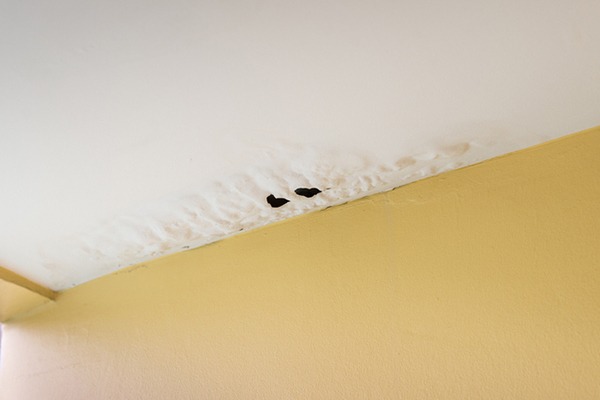A ceiling shouldn’t drip, bulge, or whistle at you in the night. Yet many homeowners ignore small clues until water starts falling like an indoor rainstorm. Spotting the early warning signs of a ceiling leak can save you thousands in repairs and a mountain of stress. Below, you’ll learn how to read the signals, handle quick first aid, and decide when to call a plumber—namely, our team at Same Day Trades.
Why Catching a Leak Early Matters
Water is sneaky. It slides along joists, hides in insulation, and shows itself only after plenty of damage is done. By then you’re dealing with mold, stained plaster, and maybe a cranky electrician who has to dry out your wires. Finding problems before they turn into disasters keeps repair bills low and your sanity intact.
The 7 Warning Signs
1. Water Stains on the Ceiling
Those pale brown rings resemble a coffee spill you forgot to wipe up. They’re telling you water found a path through the roof, plumbing, or upstairs bathroom. Even if the stain dries out, moisture can still lurk above. Note the size, snap a photo, and monitor for changes. Any new spread means trouble brewing.
2. Bubbling or Peeling Paint
Paint bubbles appear when moisture pushes against the finish. Imagine air trapped under plastic wrap—only it’s water under paint. As the bubble grows, the paint will peel, revealing damp plasterboard. If you see this, resist poking it just for fun (tempting, we know). Instead, place a towel beneath the spot and prepare for possible drips.
3. Sagging or Warped Plasterboard
A ceiling panel that bows down is carrying extra weight—usually water. This isn’t a design choice; it’s a red flag. A sagging board can split, dropping soggy plaster and insulation onto anything below. Keep people, pets, and prized guitars out of harm’s way, then move to shut off water if possible.
4. Musty or Damp Odors
If your living room smells like a forgotten gym bag, something’s off. Mold loves dark, damp hiding places. Sniff around light fixtures and corners. Trust your nose; it often discovers issues before your eyes do. Catching mold early simplifies cleanup and protects indoor air quality.
5. Dripping Sound in the Ceiling
Hear a faint plip…plip after you turn off the shower? Water may be running along timber or hitting the back of the plasterboard. It’s the house’s version of tapping you on the shoulder. Track that noise—especially during the night when other sounds are gone. Consistent drips are your cue to investigate ASAP.
6. Spike in Your Water Bill
A sudden bill increase isn’t always the water company’s fault. Hidden leaks mean water runs day and night, quietly adding liters to your usage. Compare your current bill to last month’s. If usage shot up without a change in habits—no new garden irrigation or teenage showers—suspect an internal leak.
7. Flickering Lights or Electrical Issues
Water and electricity are the ultimate odd couple. If lights dim, switches crackle, or breakers trip, water may be visiting your wiring. This can occur when water stains on the ceiling reach a fixture box. Switch off power in that area and call professionals. No one needs a shocking surprise.
Quick DIY First Aid (If You Catch a Leak)
- Kill the Power near the wet area. Safety first.
- Isolate the Water Source. Shut the isolation valve for affected bathrooms or the main if unsure.
- Contain Drips. Place a bucket under any active leak. Line it with an old tea towel to quiet the annoying drip sound—your ears will thank you.
- Relieve Pressure. If a bulge forms, poke a tiny hole with a screwdriver so water drains in a controlled stream.
- Call Same Day Trades. Professional help stops the cause, not just the symptom.
Remember, these steps prevent water damage from getting worse but do not replace a licensed repair.
When to Call Same Day Trades
- Persistent Stains. If marks grow after rain or daily showers.
- Unexplained Moisture. Damp spots with no visible source.
- Electrical Concerns. Water near lights, outlets, or wiring.
- Multiple Warning Signs. Any combo of stains, odors, and higher water bills.
Need proof? Check our detailed service page on fixing a leak coming through ceiling. We’re on call 24/7 across Adelaide, Brisbane, and Perth.
Preventive Maintenance Checklist
- Inspect roof tiles and flashing twice a year.
- Clear gutters every autumn and spring.
- Reseal showers and baths every five years.
- Check washing machine hoses for bulges or cracks.
- Test your hot-water valve yearly to spot slow leaks.
- Add a moisture detector in the ceiling cavity above the bathroom; some models alert your phone.
- Record monthly water-meter readings to catch spikes early.
Five minutes with a ladder beats five days living in a construction zone.
Conclusion: Listen to the Ceiling
A ceiling rarely shouts for help; it whispers with stains, sagging lines, and faint drops. Catch those whispers early, grab your DIY kit for short-term control, and let Same Day Trades finish the job. Your wallet, walls, and weekend plans will all breathe easier.
Need a hand today? Call or book online—it’s faster than hunting for buckets in the dark.
FAQ
Does insurance cover ceiling leaks?
Many policies cover sudden damage but not slow wear or neglect. Document signs quickly.
Can a small stain wait?
Small today, soggy tomorrow. Book an inspection before your ceiling turns into papier-mâché.
Do roof leaks only show after rain?
Mostly, plumbing leaks ignore the forecast. Keep an eye on showers and laundry cycles.






